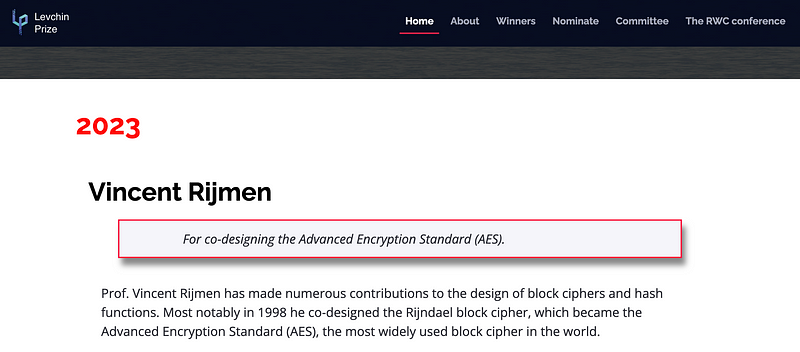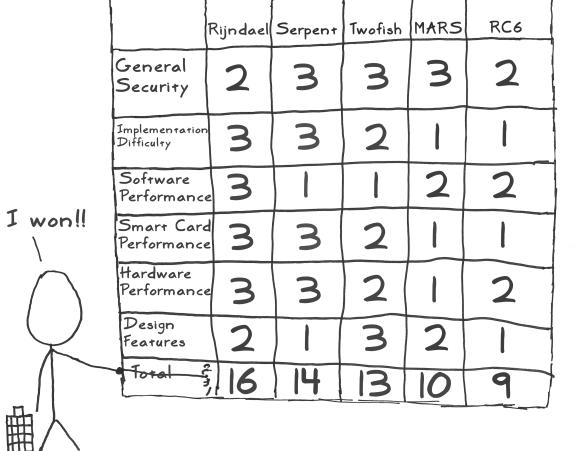Which People Have Secured Our Digital World More Than Any Other?

Which People Have Secured Our Digital World More Than Any Other?
None other than Joan Daemen and Vincent Rijmen
And, so, if you could pick one or two people who have contributed most to our online security, who would it be? Ron Rivest? Shafi Goldwasser? Ralph Merkle? Marty Hellman? Whitfield Diffie? Neal Koblitz? Well, in terms of the number of data bytes protected, that prize is likely to go to Joan Daemen and Vincent Rijmen, and who created the Rijndael method that became standardized by NIST as AES (Advanced Encryption Standard). If you are interested, Rijndael (“rain-doll”) comes from the names of its creators: Rijmen and Daemen (but don’t ask me about the rogue “l” at the end).

And, so, Joan Daemen was awarded the Levchin Prize at the Real World Symposium conference in 2016:

Now, his co-researcher, Vincent Rijmen — a Professor at KU Leuven — has been awarded the Levchin Prize at the Real-World Crypto Symposium [here]:

This follows illustrious past winners, including Paul Kocher (for work on SSL and side-channels), Dan Coppersmith (on cryptoanalysis), Neal Koblitz and Victor Miller (for their co-invention of ECC) and Ralph Merkle (for work on digital signatures and hashing trees).
Vincent’s track record in high-quality research work is exceptional and especially in the creation of the Rijndael approach to symmetric key encryption [here]:

Before AES, we had many symmetric key encryption methods, including DES, 3DES, TwoFish, BlowFish, RC4, and CAST. But AES came along and replaced these. Overall, ChaCha20 is the only real alternative to AES, and where it is used in virtually every web connection that we have and is by far the most popular method in encrypting data. And, it has stood the test of time — with no known significant vulnerabilities in the method itself. Whilst we might use weak keys and have poor implementations, Rijndael has stood up well.
AES method
With AES, we use symmetric key encryption, and where Bob and Alice share the same secret key:

In 2000/2001, NIST ran a competition on the next-generation symmetric key method, and created the race for AES (Advanced Encryption Standard). It would be a prize that the best in the industry would join, and the winner would virtually provide the core of the industry. The key evaluation factors were:
Security:
- They would rate the actual security of the method against the others submitted.
- This would method the entropy in the ciphertext — and show that it was random for a range of input data.
- The mathematical foundation of the method.
- A public evaluation of the methods and associated attacks.
Cost:
- The method would provide a non-exclusive, royalty-free basis licence across the world;
- It would be computationally and memory efficient.
Algorithm and implementation characteristics:
- It would be flexible in its approach, and possibly offer different block sizes, key sizes, convertible into a stream cipher, and so on.
- Be ready for both hardware and software implementation for a range of platforms.
- Be simple to implement.
Round 1
The call was issued on 12 Sept 1997 with a deadline of June 1998, and a range of leading industry players rushed to either create methods or polish down their existing ones. NIST announced the shortlist of candidates at a conference in August 1998, and which included some of the key leaders in the field, such as Ron Rivest, Bruce Schneier, and Ross Anderson (University of Cambridge) [report]:
- Australia LOKI97 (Lawrie Brown, Josef Pieprzyk, Jennifer Seberry).
- Belgium RIJNDAEL (Joan Daemen, Vincent Rijmen).
- Canada: CAST-256 (Entrust Technologies, Inc), DEAL (Richard Outerbridge, Lars Knudsen).
- Costa Rica FROG (TecApro Internacional S.A.).
- France DFC (Centre National pour la Recherche Scientifique).
- Germany MAGENTA (Deutsche Telekom AG).
- Japan E2 (Nippon Telegraph and Telephone Corporation)
- Korea CRYPTON (Future Systems, Inc.)
- USA: HPC (Rich Schroeppel), MARS IBM, RC6(TM) RSA Laboratories [try here], SAFER+ Cylink Corporation, TWOFISH (Bruce Schneier, John Kelsey, Doug Whiting, David Wagner, Chris Hall, Niels Ferguson) [try here].
- UK, Israel, Norway SERPENT (Ross Anderson, Eli Biham, Lars Knudsen).
One country, the USA, had five short-listed candidates, and Canada has two. The odds were thus on the USA to come through in the end and define the standard. The event, too, was a meeting of the stars of the industry. Ron Rivest outlined that RC6 was based on RC5 but highlighted its simplicity, speed, and security. Bruce Schneier outlined that TWOFISH had taken a performance-driven approach to its design, and Eli Biham outlined that SERPENT and taken an ultra-conservative philosophy for security in order for it to be secure for decades.
Round 2
And so the second conference was arranged for 23 March 1999, after which, on 9 August 1999, the five AES finalists were announced:
- Belgium RIJNDAEL (Joan Daemen, Vincent Rijmen).
- USA: MARS IBM, RC6(TM) RSA Laboratories, TWOFISH (Bruce Schneier, John Kelsey, Doug Whiting, David Wagner, Chris Hall, Niels Ferguson)
- UK, Israel, Norway SERPENT (Ross Anderson, Eli Biham, Lars Knudsen).
- Canada: CAST-256 (Entrust Technologies, Inc),
The big hitters were now together in the final, and the money was on them winning through. Ron Rivest, Ross Anderson and Bruce Schiener all made it through, and with half of the candidates being sourced from the USA, the money was on MARS, TWOFISH or RC6 winning the coveted prize. While the UK and Canada both had a strong track record in the field, it was the nation of Belgium that surprised some and had now pushed itself into the final [here].
While the other cryptography methods which tripped off the tongue, the RIJNDAEL method took a bit of getting used to, with its name coming from the surnames of the creators: Vincent Rijmen and Joan Daemen.
Ron Rivest — the co-creator of RSA, had a long track record of producing industry-standard symmetric key methods, including RC2, and RC5, along with creating one of the most widely used stream cipher methods: RC4. His name was on standard hashing methods too, including MD2, MD4, MD5, and MD6. Bruce Schneier, too, was one of the stars of the industry, with a long track record of creating useful methods, including TWOFISH and BLOWFISH.
Final
After nearly two years of review, NIST opened up to comments on the method, which ran until May 2000. A number of submissions were taken, and the finalist seemed to be free from attacks, with only a few simplified method attacks being possible:

As we can see in Table 1, the methods had different numbers of rounds: 16 (Twofish), 32 (Serpent), 10, 12, or 14 (Rijndael), 20 (RC6), and 16 (MARS). Rijndael had a different number of rounds for different key sizes, with 10 rounds for 128-bit keys and 14 for 256-bit keys. Its reduced number of rounds made it a strong candidate for being a winner.
In the AES conference to decide the winner, Rijndael received 86 votes, Serpent got 59 votes, Twofish 31 votes, RC6 23 votes, and MARS 13 votes. Although Rijndael and Serpent were similar, and where both used S-boxes, Rijndael had fewer rounds and was faster, but Serpent had better security. The NIST scoring was:

Conclusions
AES has advanced cybersecurity more that virtually all the other methods put together. Without it, the Internet would be a rats-nest of spying, person-in-the-middle attacks, and, would be a complete mess. If you want to learn how it works, try here:
and here is a video: